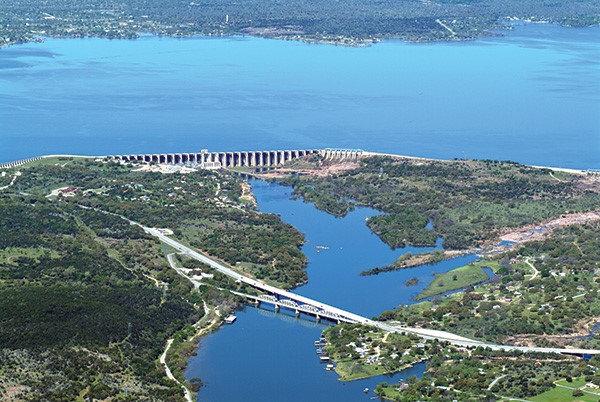Saving Austin
Sacrificing a town, creating public benefits, boosting business, and furthering political careers
Over the years a central theme of retelling the story of eminent domain and the building of the dam has been the saving of Austin. President of the Central Texas Water Coalition, Jo Karr, recounts that when the Buchanan Dam was completed in 1938
"it was done because they needed to protect Austin basically… from flooding. Austin had built a couple of dams and they blew out, so they had to be done bigger and better. And so, they put in the [Buchanan] dam … and it was designed to control the flooding."
Actually the Buchanan Dam had been started in 1931 as the Hamilton Dam by the Emory Peck and Rockwood Development Company. However, the company’s 1932 bankruptcy ended the project. Given the importance of the project to the region’s economy and further development, U.S. Congressman James Paul Buchanan successfully pressured fellow congressmen and the federal government to provide funds to complete the project. The dam was renamed Buchanan Dam in his honor.[1]
The Buchanan Dam and other projects completed along the lower Colorado River basin were the Texas version of the New Deal’s effort to electrify rural areas. Over the next few years, what the Tennessee Valley Authority had done for much of the south, Texas politicians, including a young Congressman named Lyndon Baines Johnson, did for the lower Colorado River Valley and rural Texas.
Controlling the harsh cycles of Texas weather, particularly the impact of floods and droughts on struggling low-income Texans, was another key justification for the dams. Lyndon Johnson, who had grown up poor himself, knew how a raging river could destroy lives, homes, and livelihoods—particularly the lives of families living on the margins. In 1937 he said “All our fine farm land [is] at the mercy of a river. …. It sweeps over the plains. It washes away the crops in the fields. It topples the homes… tears fences out by the roots, levels our precious forests, [and] plays checkers with bridges and roads.”[2]
Finally, the project had economic and political benefits. An additional “public good” behind the use of eminent domain in building the Buchanan Dam and other dams was the creation of construction jobs during the Depression; additionally the new hydroelectric power distribution grid in the region would provide energy to support new industries in the region. Politicians, particularly Lyndon Johnson, also recognized that the new development could also be used to benefit specific business interests—businesses that did not forget this when upwardly mobile politicians needed their support.[3]


[1] Texas State Historical Association, “Buchanan Dam” web site. https://tshaonline.org/handbook/online/articles/hjb20. Accessed January 23, 2016. Also Walter E. Long, Flood to Faucet (Austin:Walter E. Long 1956).
[2] Robert Dallek. Lone Star Rising: Vol. 1: Lyndon Johnson and His Times, 1908-1960. (Oxford University Press, 1991), p. 174.
[3] Dallek, pp. 174-184.
[4] LCRA Corporate Archives, Photograph. “Construction of Buchanan Dam.” 1932.
[5] Daniel Clifton, “Marble Falls photographer gets Down to Earth from 500 feet above,” DailyTrib.com (Keith Bedard, Photographer) November 3, 2014. http://www.dailytrib.com/2014/11/03/marble-falls-photographer-gets-earth-500-feet/. Accessed February 28, 2016.

